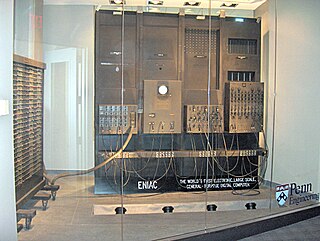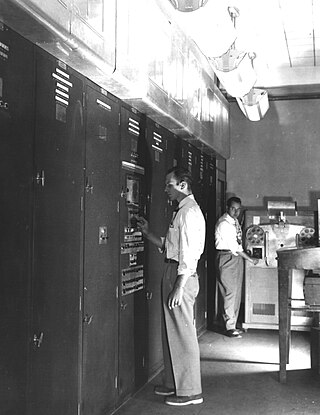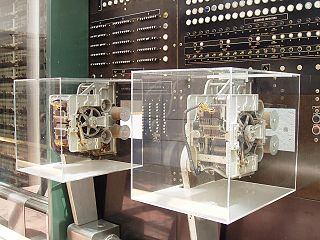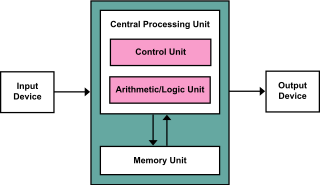Related Research Articles

A central processing unit (CPU)—also called a central processor or main processor—is the most important processor in a given computer. Its electronic circuitry executes instructions of a computer program, such as arithmetic, logic, controlling, and input/output (I/O) operations. This role contrasts with that of external components, such as main memory and I/O circuitry, and specialized coprocessors such as graphics processing units (GPUs).

The history of computing hardware covers the developments from early simple devices to aid calculation to modern day computers.

ENIAC was the first programmable, electronic, general-purpose digital computer, completed in 1945. There were other computers that had combinations of these features, but the ENIAC had all of them in one computer. It was Turing-complete and able to solve "a large class of numerical problems" through reprogramming.

John Adam Presper Eckert Jr. was an American electrical engineer and computer pioneer. With John Mauchly, he designed the first general-purpose electronic digital computer (ENIAC), presented the first course in computing topics, founded the Eckert–Mauchly Computer Corporation, and designed the first commercial computer in the U.S., the UNIVAC, which incorporated Eckert's invention of the mercury delay-line memory.

EDVAC was one of the earliest electronic computers. It was built by Moore School of Electrical Engineering, Pennsylvania. Along with ORDVAC, it was a successor to the ENIAC. Unlike ENIAC, it was binary rather than decimal, and was designed to be a stored-program computer.

John William Mauchly was an American physicist who, along with J. Presper Eckert, designed ENIAC, the first general-purpose electronic digital computer, as well as EDVAC, BINAC and UNIVAC I, the first commercial computer made in the United States.

The Z3 was a German electromechanical computer designed by Konrad Zuse in 1938, and completed in 1941. It was the world's first working programmable, fully automatic digital computer. The Z3 was built with 2,600 relays, implementing a 22-bit word length that operated at a clock frequency of about 5–10 Hz. Program code was stored on punched film. Initial values were entered manually.

The Harvard Mark I, or IBM Automatic Sequence Controlled Calculator (ASCC), was one of the earliest general-purpose electromechanical computers used in the war effort during the last part of World War II.

The IAS machine was the first electronic computer built at the Institute for Advanced Study (IAS) in Princeton, New Jersey. It is sometimes called the von Neumann machine, since the paper describing its design was edited by John von Neumann, a mathematics professor at both Princeton University and IAS. The computer was built under his direction, starting in 1946 and finished in 1951. The general organization is called von Neumann architecture, even though it was both conceived and implemented by others. The computer is in the collection of the Smithsonian National Museum of American History but is not currently on display.

Sir Maurice Vincent Wilkes was an English computer scientist who designed and helped build the Electronic Delay Storage Automatic Calculator (EDSAC), one of the earliest stored program computers, and who invented microprogramming, a method for using stored-program logic to operate the control unit of a central processing unit's circuits. At the time of his death, Wilkes was an Emeritus Professor at the University of Cambridge.

The von Neumann architecture—also known as the von Neumann model or Princeton architecture—is a computer architecture based on a 1945 description by John von Neumann, and by others, in the First Draft of a Report on the EDVAC. The document describes a design architecture for an electronic digital computer with these components:

The Manchester Baby, also called the Small-Scale Experimental Machine (SSEM), was the first electronic stored-program computer. It was built at the University of Manchester by Frederic C. Williams, Tom Kilburn, and Geoff Tootill, and ran its first program on 21 June 1948.

Herman Heine Goldstine was a mathematician and computer scientist, who worked as the director of the IAS machine at the Institute for Advanced Study and helped to develop ENIAC, the first of the modern electronic digital computers. He subsequently worked for many years at IBM as an IBM Fellow, the company's most prestigious technical position.
The First Draft of a Report on the EDVAC is an incomplete 101-page document written by John von Neumann and distributed on June 30, 1945 by Herman Goldstine, security officer on the classified ENIAC project. It contains the first published description of the logical design of a computer using the stored-program concept, which has come to be known as the von Neumann architecture; the name has become controversial due to von Neumann's failure to name other contributors.

The IBM Selective Sequence Electronic Calculator (SSEC) was an electromechanical computer built by IBM. Its design was started in late 1944 and it operated from January 1948 to August 1952. It had many of the features of a stored-program computer, and was the first operational machine able to treat its instructions as data, but it was not fully electronic. Although the SSEC proved useful for several high-profile applications, it soon became obsolete. As the last large electromechanical computer ever built, its greatest success was the publicity it provided for IBM.
Minimal instruction set computer (MISC) is a central processing unit (CPU) architecture, usually in the form of a microprocessor, with a very small number of basic operations and corresponding opcodes, together forming an instruction set. Such sets are commonly stack-based rather than register-based to reduce the size of operand specifiers.
Theory and Techniques for Design of Electronic Digital Computers was a course in the construction of electronic digital computers held at the University of Pennsylvania's Moore School of Electrical Engineering between July 8, 1946, and August 30, 1946, and was the first time any computer topics had ever been taught to an assemblage of people. The course disseminated the ideas developed for the EDVAC and initiated an explosion of computer construction activity in the United States and internationally, especially in the United Kingdom.

A computer is a machine that can be programmed to automatically carry out sequences of arithmetic or logical operations (computation). Modern digital electronic computers can perform generic sets of operations known as programs. These programs enable computers to perform a wide range of tasks. The term computer system may refer to a nominally complete computer that includes the hardware, operating system, software, and peripheral equipment needed and used for full operation; or to a group of computers that are linked and function together, such as a computer network or computer cluster.

The Manchester Mark 1 was one of the earliest stored-program computers, developed at the Victoria University of Manchester, England from the Manchester Baby. Work began in August 1948, and the first version was operational by April 1949; a program written to search for Mersenne primes ran error-free for nine hours on the night of 16/17 June 1949.

A vacuum-tube computer, now termed a first-generation computer, is a computer that uses vacuum tubes for logic circuitry. While the history of mechanical aids to computation goes back centuries, if not millennia, the history of vacuum tube computers is confined to the middle of the 20th century. Lee De Forest invented the triode in 1906. The first example of using vacuum tubes for computation, the Atanasoff–Berry computer, was demonstrated in 1939. Vacuum-tube computers were initially one-of-a-kind designs, but commercial models were introduced in the 1950s and sold in volumes ranging from single digits to thousands of units. By the early 1960s vacuum tube computers were obsolete, superseded by second-generation transistorized computers.
References
- ↑ Allison, Joanne (1997), Stored-program Computers, archived from the original on 27 September 2011, retrieved 24 August 2011
- ↑ William F. Gilreath; Phillip A. Laplante (2003). Computer Architecture: A Minimalist Perspective. Springer. p. 24. ISBN 978-1-4020-7416-5.
- 1 2 Edwin D. Reilly (2003). Milestones in computer science and information technology . Greenwood Publishing Group. p. 245. ISBN 978-1-57356-521-9.
- ↑ Murdocca, Miles J.; Vincent P. Heuring (2000). Principles of Computer Architecture. Prentice-Hall. p. 5. ISBN 0-201-43664-7.
- ↑ Daniel Page (2009). A Practical Introduction to Computer Architecture. Springer. p. 148. ISBN 978-1-84882-255-9.
- ↑ Mark Balch (2003). Complete digital design: a comprehensive guide to digital electronics and computer system architecture. McGraw-Hill Professional. p. 149. ISBN 978-0-07-140927-8 . Retrieved 18 May 2011.
- ↑ Daniel Page (2009). A Practical Introduction to Computer Architecture. Springer. p. 153. ISBN 978-1-84882-255-9.
- ↑ Ivor Grattan-Guinness (2003). Companion encyclopedia of the history and philosophy of the mathematical sciences. JHU Press. p. 705. ISBN 978-0-8018-7396-6.
- ↑ Copeland, Jack (2000). "A Brief History of Computing". ENIAC and EDVAC. Retrieved 27 January 2010.
- ↑ John L. Hennessy; David A. Patterson; David Goldberg (2003). Computer architecture: a quantitative approach . Morgan Kaufmann. p. 68. ISBN 978-1-55860-724-8.
- ↑ B. Jack Copeland (2006). Colossus: the secrets of Bletchley Park's codebreaking computers. Oxford University Press. p. 104. ISBN 978-0-19-284055-4.
- ↑ Christof Teuscher (2004). Alan Turing: life and legacy of a great thinker. Springer. p. 321–322. ISBN 978-3-540-20020-8.
- ↑ Williams, F. C; Kilburn, T (25 September 1948), "Electronic Digital Computers", Nature, 162 (4117): 487, Bibcode:1948Natur.162..487W, doi: 10.1038/162487a0 , S2CID 4110351, archived from the original on 6 April 2009
- ↑ Faber, Susanne (2000), Konrad Zuses Bemühungen um die Patentanmeldung der Z3 (in German)
- ↑ Williams, Frederic; Kilburn, Tom (1948). "Electronic Digital Computers". Nature. 162 (4117): 487. Bibcode:1948Natur.162..487W. doi: 10.1038/162487a0 . S2CID 4110351. Archived from the original on 6 April 2009.
- ↑ Rául Rojas; Ulf Hashagen (2002). The first computers: history and architectures. MIT Press. p. 379. ISBN 978-0-262-68137-7.
- ↑ Daniel Page (2009). A Practical Introduction to Computer Architecture. Springer. p. 158. ISBN 978-1-84882-255-9.
- ↑ Mike Hally (2005). Electronic brains: stories from the dawn of the computer age. National Academies Press. p. 96. ISBN 978-0-309-09630-0.
- ↑ Emerson W. Pugh (1995). Building IBM: shaping an industry and its technology. MIT Press. p. 136. ISBN 978-0-262-16147-3.
- ↑ Olley, A. (2010). "Existence Precedes Essence - Meaning of the Stored-Program Concept" (PDF). History of Computing. Learning from the Past. IFIP WG 9.7 International Conference, HC 2010. IFIP Advances in Information and Communication Technology. Vol. 325. pp. 169–178. doi: 10.1007/978-3-642-15199-6_17 . ISBN 978-3-642-15198-9.
- ↑ Graham, Loren R. (1993). Science in Russia and the Soviet Union: A Short History. Cambridge University Press. p. 256. ISBN 9780521287890.
- ↑ Emerson W. Pugh; Lyle R. Johnson; John H. Palmer (1991). IBM's 360 and Early 370 Systems . MIT Press. p. 15. ISBN 978-0-262-51720-1.
- ↑ Thomas Haigh; Mark Priestley; Crispen Rope (2016). ENIAC in Action:Making and Remaking the Modern Computer. MIT Press. pp. 153, 157, 164, 174, 194. ISBN 978-0-262-03398-5.
- ↑ Haigh, Thomas (2014). Engineering “The Miracle of the ENIAC”: Implementing the Modern Code Paradigm (PDF).
- ↑ Bruderer, Herbert (4 January 2021). Milestones in Analog and Digital Computing. ISBN 9783030409746.
- ↑ Campbell-Kelly, Martin (April 1982). "The Development of Computer Programming in Britain (1945 to 1955)". IEEE Annals of the History of Computing. 4 (2): 121–139. doi:10.1109/MAHC.1982.10016. S2CID 14861159.
- ↑ Lavington, Simon, ed. (2012). Alan Turing and his Contemporaries: Building the World's First Computers. London: British Computer Society. p. 61. ISBN 9781906124908.
- ↑ Johnson, Roger (April 2008). "School of Computer Science & Information Systems: A Short History" (PDF). Birkbeck College. University of London. Retrieved 23 July 2017.
- ↑ Hally, Mike (2005). Electronic Brains (First ed.). Granta. pp. 40–41. ISBN 978-1862076631.
- ↑ Kilburn, T; Grimsdale, R L; Webb, D C (April 1956). "A transistor digital computer with a magnetic drum store". Proceedings of the IEE - Part B: Radio and Electronic Engineering. Cambridge University Press. 103 (35): 390–406. doi:10.1049/pi-b-1.1956.0079. ISSN 2054-0434.
- ↑ Grimsdale, R L (Autumn 1995). "The Transition from Valves to Computers". Resurrection. Computer Conservation Society (13). ISSN 0958-7403.
- ↑ Carbaugh, D.H.; Marselos, N.L. (1983). "Switching System Software". In McDonald, J. C. (ed.). Fundamentals of Digital Switching Systems. Plenum Press. ISBN 0-306-41224-1.
- ↑ Joel, A. E. (October 1958). "An Experimental Electronic Switching System" (PDF). Bell Laboratories Record . 36 (10): 359–363. Retrieved 13 October 2022.
- ↑ "Electronic Central Office". Long Lines. Vol. 40, no. 5. December 1960. p. 16.